4 Tips for “Setting” a Mood — Guest: Becca Puglisi
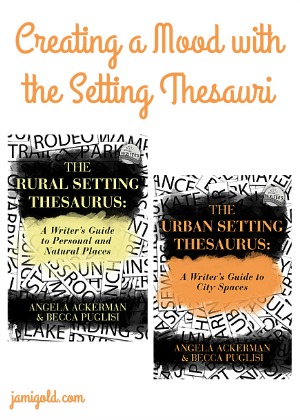
The Thesaurus books by Angela Ackerman and Becca Puglisi are a must-have for every fiction author. I’ve raved many times about the awesomeness of their Emotion Thesaurus and how we can use it to improve our writing.
We’ve also had Becca here before to talk about their Positive Trait Thesaurus and the Negative Trait Thesaurus. During her last visit, Becca shared seven tips for using the Trait Thesauri.
Now, I’m excited to announce that Angela and Becca have created two new Thesauri books: Urban Setting and Rural Setting. Yay! Even better, Becca’s here again today to talk about how setting is important for more than just describing the time and place of our scene.
Like all their books, the Setting Thesauri encourage us to dig deeper. Becca’s tips today share four aspects of setting that we might not think about, and she gives examples for how those aspects can help us set the mood of our scenes.
Please welcome Becca Puglisi! *smile*
*****
“Setting” the Mood
As Angela and I have been writing our newest thesaurus books, we’ve been amazed to discover how much a story’s setting can do. As authors, we tend to think of the setting in terms of a time and place, just a way to ground the reader in the scene. But it can accomplish so much more.
And one thing it’s really good at is establishing mood. To convey the mood of your scene to readers, just play around a bit with the four following elements of the setting until you get exactly the feel you’re looking for.
Setting Aspect #1: Weather and Seasons
The weather is a handy tool for influencing a reader’s feelings because so much of it is already emotionally charged:
- sunshine is equated with happiness,
- fog is ominous,
- rainy days are drippy and dreary and make people want to go back to bed.
Because of their universal nature, certain weather phenomena lend themselves to certain emotions, so the weather can be a useful tool for establishing the mood in a scene.
Seasons, when combined with weather elements, are similarly helpful because of their implied symbolism. Spring is all about rebirth while winter often represents death or endings.
Let’s say your story contains a childbirth scene and you’re trying to figure out when to set it. Put it in spring, with sunshine streaming through the window and birds chirping outside, and readers will get a sense of tranquility; they’ll sense that everything’s going to be okay.
But what happens if the birth occurs in the dead of winter, with a blizzard raging and the house shut up like a quarantine ward? A more ominous mood emerges, infecting the reader with worry for the laboring mother’s well being.
The weather and seasons can be very effective in conveying the proper mood in a scene, so use them thoughtfully.
Setting Aspect #2: Light and Shadow
Light in its various forms—its amount and quality, its brightness, whether it’s constant or shifting, where it’s coming from—can have a huge impact on the mood in a story. To illustrate this, let’s revisit our winter childbirth scene and see what happens when we adjust the lighting.
Icy snow pelted the windowpanes and blew sideways in the howling wind. A shutter had come loose and was slamming the side of the house, but Myra ignored it. She shut out the pain and the fear, the midwife’s soothing tones and Jeff’s good intentions, focusing instead on the calming firelight as it flickered over the floorboards.
With the rest of the lights off, she could narrow her focus to that small patch of amber-colored floor, on the light that twinkled and jumped over the oak boards, coming close to the foot of the bed but never quite reaching it—like each contraction that rose to a crescendo and threatened to overwhelm her but never quite did. She could do this; all she needed was to stay focused on the dancing light on the floor.
Childbirth is rarely a peace-filled, blissful occurrence—especially when it’s happening at home during a blizzard. Choosing that setting for the event could easily set it up as one where something bad is going to happen. But dimming the lights to an amber glow softens the mood. The steadily flickering flames lend a sense of hominess and comfort to the scene, and Myra’s steady focus on them to get her through her labor reinforces the idea that she’s going to be okay.
We could easily have altered the mood by changing the lighting. What if Myra’s room was thrown into absolute darkness due to a power outage? Add to that a still, cold fireplace casting only shadows across the floor and readers would get a totally different feel. This is the power of light and dark when it comes to setting the mood.
Setting Aspect #3: The Right Narrator
Between weather, seasons, and lighting, we can play a lot with the setting elements to determine the mood of a scene. But it’s often the people within that location that will be the biggest influencers. And none is more important than the narrator or point-of-view character.
Our childbirth scene told from Myra’s viewpoint enables readers to see her state of mind. Though frightened, she’s in control, determined to see this event through. Her absolute focus and discipline color the scene for readers. But if we showed that scene from someone else’s viewpoint, the mood could drastically change.
Icy snow pelted the windowpanes and scraped the side of the house. A shutter had come loose and was banging the wall like a hammer, sending repeated jolts of pain through Jeff’s skull.
He stood in the corner farthest from the fire, wringing his numb hands. Myra’s midwife knelt by her side, muttering words he couldn’t hear over the wind’s frantic howling; she could’ve been putting some ancient curse on his wife and Jeff wouldn’t have been able to tell.
The fire was too low to add any real warmth, but the midwife had forbidden him from building it up. Its dim light cast sickly shadows over Myra’s face while illuminating her eyes—wide and bulging and trained on something he couldn’t see.
He wished for the words that would soothe her and banish that empty, staring gaze, but she’d stopped responding to him an hour ago. This situation was going from bad to worse, and there wasn’t a thing he could do about it.
Here, Jeff is seeing a lot of the same details as Myra, but from his frightened perspective and limited viewpoint, his interpretations are very different: to him, Myra’s gaze is staring and vacant rather than focused, and the fire is ineffective and pointless, much as he feels at this moment.
One scene, two viewpoints, two wildly different moods. The viewpoint character’s emotions, fears, and experiences are always going to bleed into the narrative. Keep this in mind when choosing the narrator for each scene.
Setting Aspect #4: Foreshadowing
Foreshadowing occurs when the author hints at events to come. These events are often tied to emotions that affect the reader’s mood.
In The Wizard of Oz, this technique is used effectively when Miss Gulch shows up at the beginning of the movie. The frantic and frightening music, along with the references to her as a witch, hint at Dorothy’s future encounter with The Wicked Witch of the West. It’s a fairly creepy moment, meant to let the reader know that Miss Gulch and her Oz counterpart are going to be causing trouble down the road.
Whether you’re foreshadowing something frightening, exciting, uncertain, or morbid, there are many things that can be utilized to hint at the future, and the setting is chock full of them.
- Knickknacks and keepsakes can be used to set up down-the-road events.
- Colors within the setting, such as the many red items in The Sixth Sense, can prepare the audience for revelations to come.
- The location itself can be used to foreshadow, as we see with The Forbidden Forest in the Harry Potter series. In all the books, bad things happen there, setting up this place as a poignant location for the final showdown between Harry and Voldemort in book seven.
With the proper foundation, the setting can be extremely useful in providing exactly what is needed to foreshadow future events.
(click to see on Pinterest)
As you can see, the setting is quite a versatile tool in the author’s arsenal. Not only does it provide a time and place for story events to happen but it also can be used to set the mood.
Once you’ve decided which mood your scene should convey, just fine-tune these elements until the desired atmosphere develops. Then sit back and let the setting work its magic.
*****
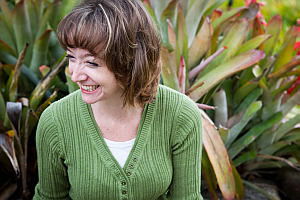 Becca Puglisi is an international speaker, writing coach, and bestselling author of The Emotion Thesaurus and its sequels, including The Rural Setting Thesaurus and The Urban Setting Thesaurus, which will be available for purchase in June.
Becca Puglisi is an international speaker, writing coach, and bestselling author of The Emotion Thesaurus and its sequels, including The Rural Setting Thesaurus and The Urban Setting Thesaurus, which will be available for purchase in June.
She is passionate about learning and sharing her knowledge with others through her Writers Helping Writers blog and via One Stop For Writers—a powerhouse online library filled with description and brainstorming tools to help writers elevate their storytelling. You can find Becca online at both of these spots, as well as on Facebook and Twitter.
*****
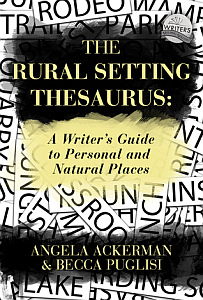 Settings should be more than a simple backdrop. Yes, they provide the opportunity to ground the reader, but they can also be used to establish mood, steer the story, foreshadow, and build tension.
Settings should be more than a simple backdrop. Yes, they provide the opportunity to ground the reader, but they can also be used to establish mood, steer the story, foreshadow, and build tension.
The Rural Setting Thesaurus helps writers like never before by exploring over 100 school, home, and natural locations, providing the sensory details for each along with possible sources of conflict that can be found there. Also covered are many figurative language techniques that can be used to convey emotion and bring the setting to life, creating a vibrant, one-of-a kind experience for readers.
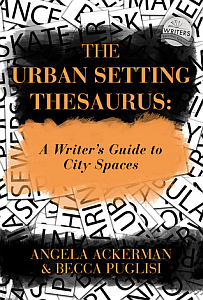 As far as story elements go, the setting is one of the most necessary, yet it’s often underutilized by writers. The Urban Setting Thesaurus is the key to creating stronger, more powerful descriptions by showing writers how multisensory details can draw readers in and enhance the story.
As far as story elements go, the setting is one of the most necessary, yet it’s often underutilized by writers. The Urban Setting Thesaurus is the key to creating stronger, more powerful descriptions by showing writers how multisensory details can draw readers in and enhance the story.
Not only will writers learn how to choose the right location for each scene, they’ll also see how the setting can be used to characterize, reveal backstory, and provide triggers that can amplify character emotions and drive behavior. Through its sensory exploration of over 120 urban settings, this book will help writers create a realistic, textured world readers will long to return to, even after the book closes.
For more information on these books,
including purchasing options,
please visit Writers Helping Writers.
*****
Thank you, Becca! You’re right that we don’t usually think of those four aspects as being part of Setting, but your examples showed exactly how the details we use can add to the sense of time and place in a scene.
I can’t wait to dig into these new Thesauri books and see what other gems of information we can learn. *smile*
What comes to mind when you think of setting? Can you see how other details of a scene, like these four aspects, add to the sense of time and place? How much do you pay attention to a scene’s mood? Have you used any of these setting aspects before to create a certain mood? Which one is your favorite?
Pin It
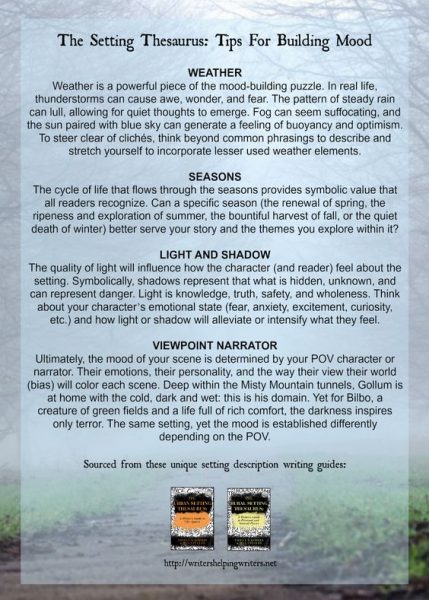
These are powerful tips. Thank you. I use the Emotion Thesaurus , the Positive Trait Thesaurus and the Negative Trait Thesaurus. I cn’t wait to get the two for settings.
Hi Sarina,
Ditto! 🙂 Love all their books!
Hi, Sarina. I’m so glad to hear that you’re liking our other books. It will be interesting to see how these two do, because the setting just isn’t something that writers tend to worry over or study much. But Angela and I believe that we’ve included some practical information that could really help authors. If you decide to get them, please let us know what you think :).
I’d already been using some of those, but hadn’t even thought of others. Thanks!
Thanks for stopping by, Deborah!
Hi Deborah,
Yes, I’ve paid attention to most of these on a subconscious level, but seeing the specific effects explained with these examples is great for bringing them into our consciousness so we can ensure we give them the proper emphasis. 🙂 Thanks for the comment!
Whoa! What a great article on setting. Thanks Becca. Also thanks to Jami for inviting you.
Especially liked #2. Maybe the most obvious, but a little different look at it for me.
I’m a newsletter subscriber to Becca’s (and Angela’s), and yours, Jami. when one of you is guest on the other’s blog, I feel like I’m reading an article by a friend
What a nice thing to say, JC. Jami is a doll for letting us crash here so often. I learn so much from her blog.
Hi JC,
I’m thrilled whenever I get a chance to bring Angela or Becca over, so I’m glad you enjoy these visits too! 🙂
Yes! As I mentioned to Deborah, I’ve thought about #2 sometimes, but often just at a subconscious level, so it’s great to learn how to really make the most of the technique. Thanks for stopping by!
[…] I highly recommend reading it if you are fiction author. There are some helpful tips. The link for the article is HERE. […]
Nice tips! I haven’t thought about the lighting one before, at least not in this context (I pay attention to dark and light in movies, though, lol.) For weather and seasons, I think they can feel cliché to the reader sometimes —not all the time, just sometimes. It would be fun to see an author contrast the weather with the actual mood, e.g. dark winter with a snow storm, but it’s actually during a happy event. Of course there’s a risk that the reader will get confused, misled, or the reader could be made to worry about nothing; but it could create some nice comedic effect if handled well! In my opinion.
Hi Serena,
Good point about the weather! As a matter of fact, in their old online version of the Weather Thesaurus (before they started publishing their books), Becca and Angela would usually point out the cliches associated with different weather events so authors could be careful about following them too closely without a twist. 🙂 Thanks for that reminder!
Cool! I’m glad they covered that too.
[…] if you like, get sensory in your description to power up every scene, learn mood-building techniques or discover why the setting is the key to delivering active backstory when you need […]
[…] posts, I encourage you to check them out. They shared their expertise on entrepreneurship, Tumblr, using setting to enhance a mood, and empowering description with […]
[…] if you’d like more information on creating mood, visit Jami Gold’s terrific blog. […]
[…] 4 Tips for “Setting” a Mood […]
[…] decide on right tone/mood/feel for scene […]
[…] These books have helped transform my writing. Their Emotion Thesaurus is the best resource for showing our characters’ emotions, writing in deep point of view, and helping us fix four common writing problems. Becca’s also visited us with tips on how to use the Trait Thesauri books to create characters and how to use the Settings books to create a mood. […]
[…] how to pick the right words for tone/mood/feel […]
[…] We’ve also had Becca here before to talk about some of their other Thesaurus books. During her visits, Becca’s shared seven tips for using the Trait Thesauri and four tips for using the Setting Thesauri books. […]
[…] the character is on the inside. We can include deeper descriptions with our settings too:Does the setting evoke a certain mood or atmosphere (cold and unforgiving or vibrant and peaceful)? Does it symbolize something to characters (or to […]